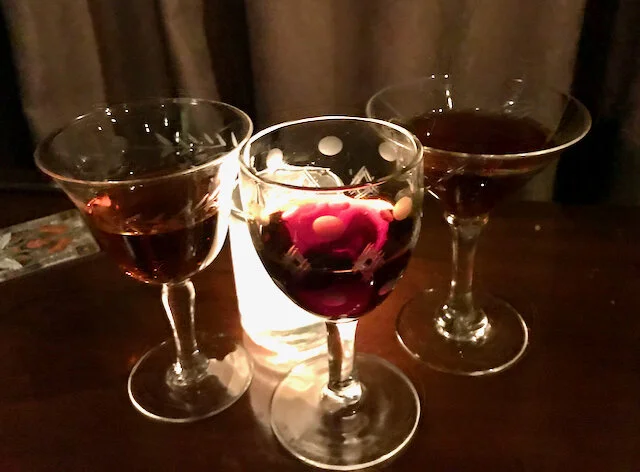Don’t Be Afraid of the Dark...
“We’ll just go for salads and a cocktail.” Right. The road to Hell is paved with good (and sometimes tasty!) intentions. Who knew when my dining partner and I made our first trip to Quaintrelle, we’d end up having a stellar three-course dinner and an impromptu amaro tasting that would spawn a blog post?
A few years ago, when I was part-owner of a small Italian wine importing business, I had the good fortune to travel to Italy on buying trips several times a year. I absolutely fell in love with the Italian countryside (what’s not to love?), the people, the culture, and the traditions surrounding food and drink. I set out to bring many of the Italian traditions home with me to my ‘real’ life back in Portland, Oregon.
Over many delightful trips, I learned to cook some really delicious dishes, learned about pairing wines with foods (look for upcoming classes here), and learned to love luxuriating in a glass of amaro digestivo after a long and tasty meal.
Amaro liqueurs have a long history in Italy, dating back to the Roman Empire. After a hedonistic bacchanalia thrown by the wealthy patricians, revelers would drink herb-infused wine to help restore their vigor. By the middle ages, distilled alcohol was substituted for the wine, and monasteries were creating proprietary blends of herbs, seeds and barks and using them for their medicinal value. By the 1800s, amari were becoming a lucrative industry, and were being sold in pharmacies as health tonics. Nowadays, every restaurant, cafe and bar in Italy has some kind of high-proof amaro on offer for their customers to enjoy.
This was one tradition I found challenging to bring back home with me. Few restaurants offer them on their menu, and when they do, they are often used as a substitute for sweet vermouth in a cocktail. Checking my local liquor store revealed a few bottles of Frenet Branca* (interesting in a cocktail, but not my favorite to drink on its own).
Given the lack of good amaro options, this is why I was tickled pink to see an Amaro Flight on the dessert menu at Quaintrelle. The fortunate diner can choose a glass from multiple offerings in each flavor category: Light and Sweet; Medium-Bodied and Robust; and Full-Bodied and Bitter.
Depending on the botanicals used in the production, amari can range in color from bright ruby to deep garnet, golden amber to dark brown, and pale chartreuse to murky forest green. To the beginner, some of these colors may be a bit…. unnerving. Don’t be afraid of the dark! With a few exceptions, the darker the color, the more complex and interesting the flavor profile.
For our Light and Sweet selection, we chose Caffo Vecchio del Capo from Calabria. This orange-y amber elixir hit us with forward notes of cardamom and cinnamon, orange peel and lighter chamomile. The aroma and flavor were somewhat cola-like, with a fresh herbal finish.
Moving on to the Medium-Bodied and Robust, we selected Amaro 1779 from the Grappa-producing powerhouse Nardini in the Veneto region. (Their motto is, “If it’s not Nardini, what grappa is it?”). This one was a sensory surprise! Ruby-red, the aroma was decidedly a mix of maple, black walnut and prune—earthy, sweetly resinous and fruity. When we tasted it, WOW! What a contrast with the flavor. Menthol and licorice, with a pleasantly medicinal quality. Not at all what we were expecting, but truly delightful, nonetheless.
We were ready for anything by the time we tasted our Full-Bodied & Bitter selection—this time from Lombardia, in the Alps—with Braulio Alpino. This little gem has a mahogany-brown tint from aging in oak for 2 years before bottling. With a full body mouthfeel, the Alpine herbs gave it the decidedly medicinal flavor of eucalyptus, with mint, anise and juniper bringing up the minor notes. This one could be a stretch for a beginner, but I think the flavor will grow on you. It’s definitely the one that adheres closest to the ‘digestivo’ qualities, and can be a soothing finish to a rich, lavish dinner.
I encourage you to ‘dip a toe’ into the brackish waters of Italian amari . Ask your go-to Italian restaurant if they have any on the menu. Drink it neat or over ice. Ask your favorite savvy bartender to add some to your Manhattan or Old-Fashioned—you might find a whole new world of spicy, herby goodness!
* In recent years, some ‘upscale’ liquor stores are carrying more options—if your local store doesn’t carry them—ask them to!
Cheers,
Teresa
Want more Deliciousness in your Inbox? Subscribe HERE

